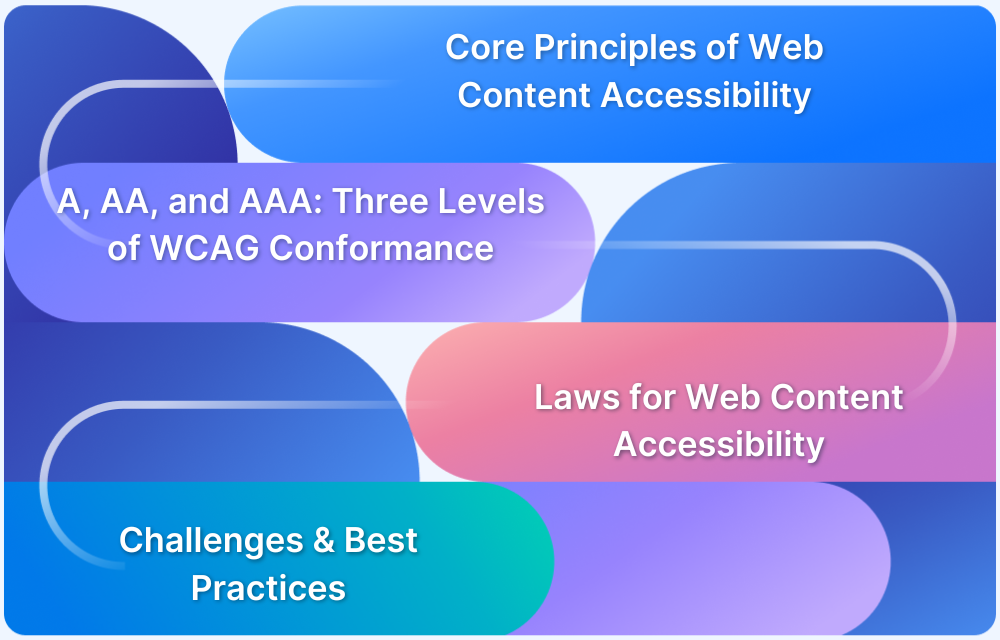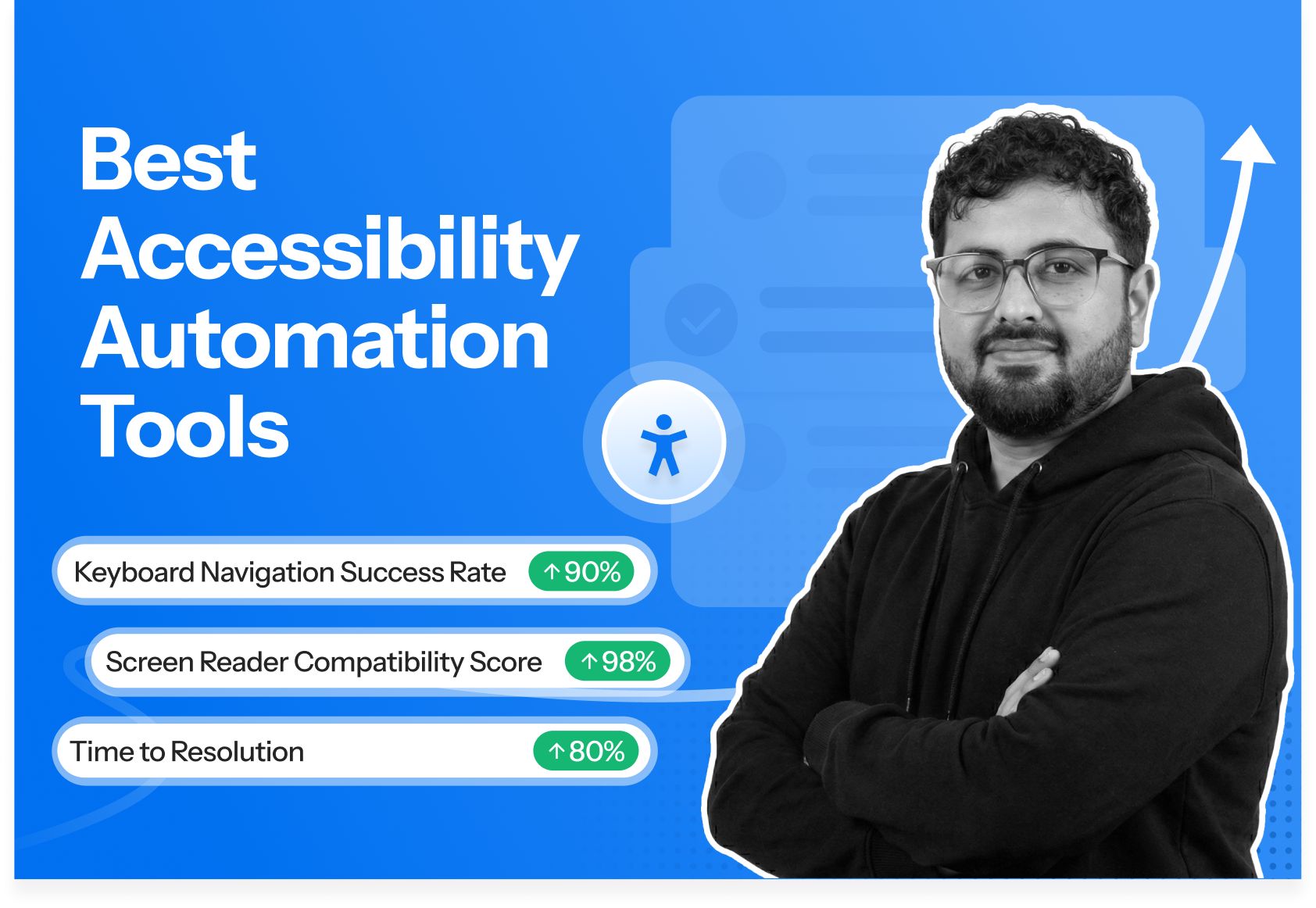Accessibility involves designing websites, apps, and digital tools in a way that they work for everyone, including people with disabilities.
Overview
What is Accessibility Testing?
Accessibility testing ensures people with disabilities can use your website, app, or software. It checks if assistive tools like screen readers can access content correctly and if your product meets legal accessibility rules.
Manual vs. Automated Accessibility Testing: Key Differences
Here’s how automated and manual accessibility testing differ from each other.
| Aspect | Manual Accessibility Testing | Automated Accessibility Testing |
|---|---|---|
| What it checks | Real user experience with assistive technologies and alternative inputs | Code and design patterns for common accessibility issues |
| Strength | Finds usability barriers and issues that affect task completion | Scans large codebases quickly and flags standard issues |
| Effort | Takes time and needs skilled testers | Fast and can run in CI/CD pipelines |
| Consistency | Can vary between testers and sessions | Produces consistent, repeatable results |
This article explains the difference between manual and automated accessibility testing and when to use each.
What Is Accessibility Testing?
Accessibility testing checks if digital products are usable for people with disabilities. It focuses on verifying that websites, apps, and documents meet standards that help users who rely on assistive technologies such as screen readers or keyboard navigation.
Accessibility testing looks at how users with different needs interact with digital interfaces. It ensures that people with visual, auditory, motor, or cognitive disabilities can access content and complete tasks without barriers.
Why Is Accessibility Testing Important?
Accessibility testing is critical for several reasons:
- Legal compliance: Laws like the Americans with Disabilities Act (ADA), Section 508, and Accessibility for Ontarians with Disabilities Act (AODA) require accessible digital content. Failure to comply can result in legal action, penalties, and forced remediation.
- Better user experience: Accessible design often improves usability for everyone, including people without disabilities. For example, captions help in noisy places, and good color contrast helps people read content in bright light.
Read More: What is User Experience (UX) Design?
- Ensures compatibility with assistive technologies: Accessibility testing helps verify that underlying code (like ARIA labels, semantic HTML, and focus management) works as intended with screen readers, braille displays, and voice input tools. This prevents silent failures that don’t show up in basic manual checks or visual reviews.
- Strengthens long-term maintainability: Building and testing for accessibility enforces clean code practices, structured markup, and consistent component behavior. This makes it easier for teams to update, extend, or refactor systems without breaking critical user flows for people with disabilities.
- Reveals usability gaps: Thorough accessibility testing often uncovers interaction issues that affect everyone, such as keyboard traps, focus loss, or inconsistent state management, which standard functional testing can miss.
Read More: What is Usability Testing? (Methods & Tools)
Manual Accessibility Testing
Manual testing means a tester checks how a website or app works for people with disabilities by using it like they would. The tester looks for real-world barriers that automated tools might miss, like confusing focus order, missing labels, or poor screen reader output.
Manual accessibility testing involves:
- Keyboard navigation: The tester checks if everything can be done without a mouse by using only the keyboard.
- Screen reader support: The tester uses a screen reader like NVDA or Orca to see if text, buttons, links, and other elements are announced clearly and correctly.
Read More: How to Test Websites with Screen Readers
- Focus order and visibility: The tester checks that focus moves logically and is always visible on the screen.
- Color contrast and visual clarity: The tester checks if text and interactive elements have enough contrast and are easy to read.
- Form labels and error messages: The tester ensures form fields have proper labels and that error messages are clear and tied to the right fields.
Tools for Manual Accessibility Testing
These tools help testers check different parts of accessibility:
- BrowserStack: A real device cloud testing platform that allows testers to check accessibility on real devices and browsers in real-world conditions.
- NVDA: An open-source screen reader for Windows that lets testers hear how content is announced.
- Orca: An open-source screen reader for Linux that helps testers check how screen readers interpret content.
- tota11y: A visual tool that adds an overlay to a webpage to highlight accessibility issues during manual review.
- Fangs Screen Reader Emulator: A Firefox extension that shows what a screen reader would announce for a page.
Here are the advantages and disadvantages of manual accessibility testing.
| Strengths of Manual Accessibility Testing | Limitations of Manual Accessibility Testing |
|---|---|
| Identifies alt text that doesn’t clearly describe images | Time‑consuming for large or complex websites |
| Verifies how screen readers and voice controls work in real scenarios | Requires skilled testers who understand accessibility standards |
| Detects issues in dynamic content and user flows | Difficult to repeat consistently across releases |
| Ensures if users can complete actual tasks successfully | Results can vary based on the tester’s expertise and experience |
Automated Accessibility Testing
Automation testing uses software to scan websites, apps, or code for common accessibility issues. These tools check technical elements against standards like WCAG (Web Content Accessibility Guidelines). The goal is to catch patterns of mistakes in markup or styling that can block access for users with disabilities.
Automated accessibility testing involves:
- Scanning HTML, CSS, JavaScript, and ARIA markup for missing or incorrect attributes
- Checking color contrast between text and backgrounds
- Flagging missing form labels, empty links, and incorrect heading structure
- Checking ARIA labels and properties for correct use
- Generating reports with the exact location of issues in the code
- Integrating checks into CI/CD pipelines to catch the problems before release
Read More: How to Automate Accessibility Testing
Tools for Automated Accessibility Testing
Here are the best automated accessibility testing tools in 2025.
- BrowserStack: It integrates with test suites and CI/CD pipelines to trigger automated scans during builds and helps verify accessibility against standards like WCAG, ADA, and Section 508 on real devices.
- Accessibility Insights for Web: An open-source browser extension that runs automated checks and highlights issues visually.
- AChecker: An open-source online tool that checks HTML content against various accessibility guidelines.
- HTML_CodeSniffer: An open-source JavaScript tool that checks a web page for conformance with accessibility standards.
Here is a table highlighting the advantages and disadvantages of automated accessibility testing.
| Strengths of Automated Accessibility Testing | Limitations of Automated Accessibility Testing |
|---|---|
| Quickly scans large websites and apps for code-level and pattern-based issues | Can miss issues that require human judgment, such as alt text or logical reading order |
| Integrates with CI/CD to catch issues during builds | May generate false positives that require manual review |
| Runs consistent checks with no variation or tester bias | May miss certain interactions with assistive technologies |
| Generates reports that track issues across builds and releases |
Manual vs Automated Accessibility Testing
Manual and automated accessibility testing work together to ensure a product is truly accessible. Manual testing checks real user experience, while automated testing scans code for common issues.
Here’s how manual vs automated accessibility testing compares.
| Aspect | Manual Accessibility Testing | Automated Accessibility Testing |
|---|---|---|
| What it is | A person uses the product like a real user would, with tools like screen readers or keyboards. | A tool scans the code to find common accessibility problems. |
| What it covers | User experience with assistive technologies, task completion, forms, focus, and errors. | Code-level checks like missing alt text, low contrast, and wrong heading structure. |
| Strength | Finds problems that stop users from completing tasks, like bad focus or unclear errors. | Quickly checks large amounts of code for standard mistakes. |
| Weakness | Takes more time and needs skilled testers. | Misses problems with tasks, dynamic content, or real assistive tech behavior. |
| Consistency | Can vary depending on the tester. | Always runs the same checks the same way. |
| Best for | Checking real user experience and task flows. | Catching common code errors early during development. |
| Handles dynamic content | Can check if popups, dropdowns, and live updates work properly. | Often misses problems when content updates or changes frequently on the page. |
| Focus on task completion | Checks if users can finish forms, place orders, or complete key actions. | Does not check if tasks can be completed, but the code behind them. |
| Adaptation to edge cases | Can adjust to unusual layouts, custom components, or unexpected patterns during testing. | Follows fixed rules and may miss unique or non-standard patterns. |
| Workflow validation | Tests full flows like filling forms, fixing errors, and completing actions across screens. | Checks single pages or components, not how they work together in a task. |
When to Choose Manual Accessibility Testing
Manual testing is the better choice when you want to
- Check how assistive tech behaves with dynamic content, like modals, dropdowns, or live updates.
- Test full user workflows, such as filling forms, fixing errors, and completing key tasks.
- Verify custom components or patterns that automated tools may not understand.
- Ensure that error messages, alt text, or labels actually help users complete actions.
When to Choose Automated Accessibility Testing
Automated testing is best used when you want to
- Run fast, repeatable checks for standard code issues across many pages or builds.
- Integrate accessibility checks into your CI/CD pipeline to catch issues early.
- Enforce minimum accessibility standards during development without adding manual effort at every step.
- Scan large sites or apps where manual testing of every page isn’t practical.
Also Read: Manual Testing vs Automation Testing
How BrowserStack Facilitates Both Manual and Automated Accessibility Testing
With BrowserStack Accessibility, you can test on 3,500+ real devices, browsers, and OS combinations without setting up your own device farm. This reduces setup effort, keeps testing consistent across teams, and helps ensure that accessibility is validated at both the code and user-experience levels.
Here’s how BrowserStack Accessibility helps.
- Manual Testing: BrowserStack gives testers access to real devices, operating systems, and browsers to manually check how assistive technologies like screen readers, screen magnifiers, and keyboard navigation behave in real conditions. Testers can interact with the product as users would, across different environments.
- Automated Testing: BrowserStack integrates with automation frameworks like Selenium, Playwright, and Cypress so teams can run automated accessibility checks as part of functional test scripts. It supports running these tests on real devices and browsers during builds through CI/CD pipelines, helping catch code-level accessibility issues early.
Conclusion
Accessibility testing needs both manual and automated approaches to give full coverage. Automated checks help catch common code-level issues early and at scale, while manual testing ensures that users with disabilities can actually complete tasks and interact with your product.
BrowserStack helps teams combine both methods in one place so they can test in real user conditions and deliver accessible, reliable digital experiences. It also helps ensure compliance with WCAG, ADA, Section 508, EAA, and AODA.







